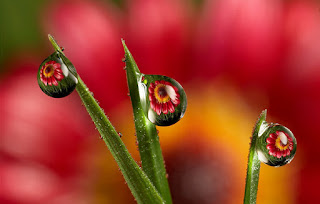
Focus stacking
Focus stacking can be used to increase the available depth of field in a shot. You might want to do this where you just can't get the required DOF no matter what aperture you use, or where you are using fairly open apertures to minimize diffraction softening but still want to significant DOF.
First you need to download and install CombineZM.
For people that do not want to download the free software you can also perform this in Photoshop manually using layers and masks.
Taking pics for a stack
You need a subject which is not moving whilst taking the photos. I tend to use fixed focus and move the camera until the first part of the subject comes into focus, take a shot, and note where the subject is just going out of focus. Then move the camera trying to keep the FOV similar and not rotating the camera until the OOF area in the previous shot just comes into focus. Continue doing this until you have covered the required DOF.
If you are using a tripod (perhaps recommended for first goes at this) then do the same thing but use the focus ring to move to the next "slice".
On the website are 3 shot slices for this stack of a damselfly sitting next to its exuvium (empty shell): one with the Close objects in focus, one with the far objects in focus and one with the middle objects in focus.
http://www.wonderfulphotos.com/articles/macro/focus_stacking/
Stacking the images (screen shots are on the website
http://www.wonderfulphotos.com/articles/macro/focus_stacking/
Focus stacking can be used to increase the available depth of field in a shot. You might want to do this where you just can't get the required DOF no matter what aperture you use, or where you are using fairly open apertures to minimize diffraction softening but still want to significant DOF.
First you need to download and install CombineZM.
For people that do not want to download the free software you can also perform this in Photoshop manually using layers and masks.
Taking pics for a stack
You need a subject which is not moving whilst taking the photos. I tend to use fixed focus and move the camera until the first part of the subject comes into focus, take a shot, and note where the subject is just going out of focus. Then move the camera trying to keep the FOV similar and not rotating the camera until the OOF area in the previous shot just comes into focus. Continue doing this until you have covered the required DOF.
If you are using a tripod (perhaps recommended for first goes at this) then do the same thing but use the focus ring to move to the next "slice".
On the website are 3 shot slices for this stack of a damselfly sitting next to its exuvium (empty shell): one with the Close objects in focus, one with the far objects in focus and one with the middle objects in focus.
http://www.wonderfulphotos.com/articles/macro/focus_stacking/
Stacking the images (screen shots are on the website
http://www.wonderfulphotos.com/articles/macro/focus_stacking/
- Run CombineZM and load the files by clicking on File -> New.
- Load in the images you wish to stack.
- To do the stack, click on Macro -> Do Stack
- The program will then start comparing the shots, aligning them, and color matching them.
- CombineZM will find detail and apply low and high pass filters before the stacked image appears.
- Use the File -> Save Frame/Picture as dialogue to name and save the picture.
- You'll notice that in this stacked picture, there is some distortion on the right hand side. This is normal and is caused by the slight change in FOV that has to occur in the different slices (ie. that part of the image was missing in some of the slices). You just crop this off in PP. However there is also some disappointing noise blotching in the background.
- You may also see some haloing (not in this example) around high contrast edges. The latter two defects are caused by misalignment of the shots. This can sometimes be helped by clicking on Stack -> Reverse order and doing the stack again.
- However, a more precise way of dealing with it is to align the pictures manually before doing the stack. Doing this will also correct any rotational errors present in the different slices. See the link for more information about manually alignment.

Check out other great images by © Brian Valentine on his website
No comments:
Post a Comment